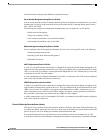
You do not need to configure these hardware components directly.
Server Identity Management through Service Profiles
You can use the network and device identities burned into the server hardware at manufacture or you can use
identities that you specify in the associated service profile either directly or through identity pools, such as
MAC, WWN, and UUID.
The following are examples of configuration information that you can include in a service profile:
• Profile name and description
• Unique server identity (UUID)
• LAN connectivity attributes, such as the MAC address
• SAN connectivity attributes, such as the WWN
Operational Aspects configured by Service Profiles
You can configure some of the operational functions for a server in a service profile, such as the following:
• Firmware packages and versions
• Operating system boot order and configuration
• IPMI and KVM access
vNIC Configuration by Service Profiles
A vNIC is a virtualized network interface that is configured on a physical network adapter and appears to be
a physical NIC to the operating system of the server. The type of adapter in the system determines how many
vNICs you can create. For example, a converged network adapter has two NICs, which means you can create
a maximum of two vNICs for each adapter.
A vNIC communicates over Ethernet and handles LAN traffic. At a minimum, each vNIC must be configured
with a name and with fabric and network connectivity.
vHBA Configuration by Service Profiles
A vHBA is a virtualized host bus adapter that is configured on a physical network adapter and appears to be
a physical HBA to the operating system of the server. The type of adapter in the system determines how many
vHBAs you can create. For example, a converged network adapter has two HBAs, which means you can
create a maximum of two vHBAs for each of those adapters. In contrast, a network interface card does not
have any HBAs, which means you cannot create any vHBAs for those adapters.
A vHBA communicates over FCoE and handles SAN traffic. At a minimum, each vHBA must be configured
with a name and fabric connectivity.
Service Profiles that Override Server Identity
This type of service profile provides the maximum amount of flexibility and control. This profile allows you
to override the identity values that are on the server at the time of association and use the resource pools and
policies set up in Cisco UCS Manager to automate some administration tasks.
You can disassociate this service profile from one server and then associate it with another server. This
re-association can be done either manually or through an automated server pool policy. The burned-in settings,
Cisco UCS Manager GUI Configuration Guide, Release 2.0
OL-25712-04 13
Server Architecture and Connectivity


















